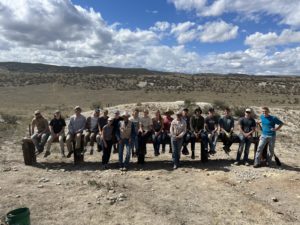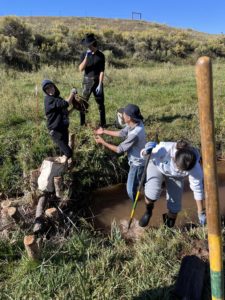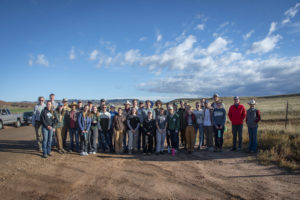Ecological restoration, which aims to rehabilitate an ecosystem that has been disturbed or damaged, has the potential to become a new form of outdoor recreation that benefits both people and the planet.
That’s according to Rick Knight, professor in the Human Dimensions of Natural Resources Department in the Warner College of Natural Resources at Colorado State University.
“Ecological restoration has the criteria of outdoor recreation,” Knight said. “You’re outside, you’re with friends or family, you’re getting sunshine and your muscles are sore at the end of the day.”
Knight invites his students from his NR120 Environmental Conservation class to participate in what he calls “restoration workdays.” The class gives students an overview of natural resources environmental concerns and the workdays allow students to actually participate in ecological restoration efforts in their own communities.
The workdays occur on select Saturdays throughout the semester where students congregate to work on degraded land in the surrounding Fort Collins area. During Knight’s Fall 2022 class, two of the workdays occurred on the 17,000 acre conserved Roberts Ranch in Livermore, Colorado. The Roberts Ranch, currently managed by Zach Thode, has a long history in the Livermore valley dating back to the original homestead in 1874.
Day 1: Crossing to Safety

On the first ecological restoration workday, students installed a wildlife-friendly crossing. The crossing was built by removing barbed wire fencing and replacing it with vertical uprights supporting a log placed horizontally 40 inches above the ground. The contraption contains livestock while allowing wildlife to migrate over or under the crossing without injuring themselves on the barbed wire
Day 2: Collaborating for the Floodplains

Restoring the floodplains was a large undertaking and involved a collaborative effort with a local nonprofit, Wildland Restoration Volunteers. The project was coordinated by Nate Boschmann, a program manager for WRV. Boschmann and the team of volunteers at WRV work to build diverse communities that care for the land through participating in ecological restoration of degraded lands. The project focused on slowing down the water flow to reduce soil erosion along a riverbed in the Livermore Valley.
Students worked with volunteers to implement induced meanders into the river to redirect the water flow. This helps to slow down erosion and restore the riverbeds. Induced meanders use instream structures, manipulations of stream bank vegetation, and the power of running water to redirect the water flow and promote floodplain development.
“There is an intangible aspect of engaging volunteers in this type of restoration work,” said Boschmann. “It exposes a greater number of people to the natural beauty of this place. They gain a better understanding of the impacts we have on our landscapes and what it takes to restore them.”
For this project, the environmental conservation students were joined by club members from the CSU Backcountry Hunters & Anglers, The Wildlife Society Student Chapter, and Society for Ecological Restoration Student Chapter along with a group of students from Front Range Community College. The collaboration allows students from FRCC who are interested in transferring to a program offered at CSU to meet future classmates and start to feel connected to the university.

“Mixing programs allows students to work alongside others with very different backgrounds which helps to break down barriers and stigmas,” said Heather Dannahower, professor in the Department of Forest, Wildlife and Natural Resources at FRCC. “I enjoy watching students make a difference and see the satisfaction on their faces from the work they’ve done.”
By participating in these workdays students gained a greater understanding of ecological restoration efforts while engaging in a new form of outdoor recreation.
“I really enjoyed the sense of accomplishment at the end of the day after doing something good for the environment rather than hurting it,” said Ty Hawke, a freshman studying Ecosystem Science and Sustainability. “I came back home from the day with dirt on my hands and a smile on my face. I learned that restoring ecosystems is not as unapproachable as I once thought. There are plenty of opportunities for people to help their local environment if they just look for them.”